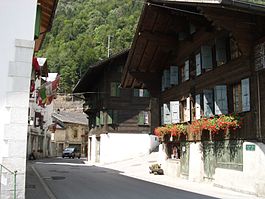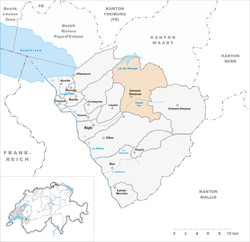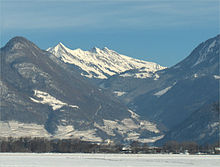- Ormont-Dessous
-
Ormont-Dessous Le Sépey village Country Switzerland 
Canton Vaud District Aigle 46°22′N 7°03′E / 46.367°N 7.05°ECoordinates: 46°22′N 7°03′E / 46.367°N 7.05°E Population 1,004 (Dec 2009)[1] - Density 16 /km2 (41 /sq mi) Area 64.07 km2 (24.74 sq mi)[2] Elevation 705 m (2,313 ft) Postal code 1863 SFOS number 5410 Demonym Les Ormonans Localities Cergnat, La Comballaz, La Forclaz (Ormont-Dessous) Surrounded by Château-d'Œx, Ormont-Dessus, Ollon, Aigle, Leysin, Corbeyrier, Villeneuve (VD) Website www.ormont-dessous.ch
Profile, SFSO statisticsOrmont-Dessous is a municipality of the canton of Vaud in Switzerland, located in the district of Aigle.
Contents
History
Ormont-Dessous is first mentioned in 1200 as Ormont. In 1564 it was mentioned as Bas-Ormont. The German name Ormund is no longer used.[3]
Geography
Ormont-Dessous has an area, as of 2009[update], of 64.07 square kilometers (24.74 sq mi). Of this area, 24.93 km2 (9.63 sq mi) or 38.9% is used for agricultural purposes, while 29.07 km2 (11.22 sq mi) or 45.4% is forested. Of the rest of the land, 2.05 km2 (0.79 sq mi) or 3.2% is settled (buildings or roads), 1.26 km2 (0.49 sq mi) or 2.0% is either rivers or lakes and 6.71 km2 (2.59 sq mi) or 10.5% is unproductive land.[4]
Of the built up area, housing and buildings made up 1.3% and transportation infrastructure made up 1.7%. Out of the forested land, 37.8% of the total land area is heavily forested and 4.8% is covered with orchards or small clusters of trees. Of the agricultural land, 0.0% is used for growing crops and 10.6% is pastures and 28.3% is used for alpine pastures. Of the water in the municipality, 1.8% is in lakes and 0.2% is in rivers and streams. Of the unproductive areas, 7.2% is unproductive vegetation and 3.2% is too rocky for vegetation.[4]
The municipality is located in the Aigle district, in the middle of the Grande-Eau valley. It consists of the villages of Ormont, Dessous, Le Sépey and La Forclaz as well as scattered settlements at Cergnat, Matélon, La Comballaz and Les Voëttes.
Coat of arms
The blazon of the municipal coat of arms is Gules, from three Hills Or rising a Tower Argent masoned and windowed Sable between four, two and two, Mullets of Five Argent. This coat of arms might be an example of canting with Ormont-Dessous being read as Or-Mont-Dessous or Gold(en)-Mount-Below.[5]
Demographics
Ormont-Dessous has a population (as of December 2009[update]) of 1,004.[1] As of 2008[update], 9.6% of the population are resident foreign nationals.[6] Over the last 10 years (1999–2009 ) the population has changed at a rate of 3.4%. It has changed at a rate of 9.2% due to migration and at a rate of -5.5% due to births and deaths.[7]
Most of the population (as of 2000[update]) speaks French (1,000 or 93.0%), with German being second most common (33 or 3.1%) and Portuguese being third (16 or 1.5%). There are 8 people who speak Italian.[8]
Of the population in the municipality 368 or about 34.2% were born in Ormont-Dessous and lived there in 2000. There were 321 or 29.9% who were born in the same canton, while 150 or 14.0% were born somewhere else in Switzerland, and 127 or 11.8% were born outside of Switzerland.[8]
In 2008[update] there were 10 live births to Swiss citizens and were 20 deaths of Swiss citizens. Ignoring immigration and emigration, the population of Swiss citizens decreased by 10 while the foreign population remained the same. There were 3 Swiss men who immigrated back to Switzerland. At the same time, there was 1 non-Swiss man who immigrated from another country to Switzerland. The total Swiss population change in 2008 (from all sources, including moves across municipal borders) was a decrease of 18 and the non-Swiss population decreased by 16 people. This represents a population growth rate of -3.3%.[6]
The age distribution, as of 2009[update], in Ormont-Dessous is; 91 children or 9.1% of the population are between 0 and 9 years old and 122 teenagers or 12.2% are between 10 and 19. Of the adult population, 81 people or 8.1% of the population are between 20 and 29 years old. 139 people or 13.8% are between 30 and 39, 139 people or 13.8% are between 40 and 49, and 153 people or 15.2% are between 50 and 59. The senior population distribution is 135 people or 13.4% of the population are between 60 and 69 years old, 70 people or 7.0% are between 70 and 79,there are 58 people or 5.8% who are 80 and 89, and there are 16 people or 1.6% who are 90 and older.[9]
As of 2000[update], there were 337 people who were single and never married in the municipality. There were 556 married individuals, 93 widows or widowers and 89 individuals who are divorced.[8]
As of 2000[update] the average number of residents per living room was 0.47 which is less people per room than the cantonal average of 0.61 per room.[7] In this case, a room is defined as space of a housing unit of at least 4 m2 (43 sq ft) as normal bedrooms, dining rooms, living rooms, kitchens and habitable cellars and attics.[10] About 69.6% of the total households were owner occupied, or in other words did not pay rent (though they may have a mortgage or a rent-to-own agreement).[11]
As of 2000[update], there were 500 private households in the municipality, and an average of 2. persons per household.[7] There were 210 households that consist of only one person and 22 households with five or more people. Out of a total of 531 households that answered this question, 39.5% were households made up of just one person and there were 8 adults who lived with their parents. Of the rest of the households, there are 146 married couples without children, 103 married couples with children There were 23 single parents with a child or children. There were 10 households that were made up of unrelated people and 31 households that were made up of some sort of institution or another collective housing.[8]
In 2000[update] there were 701 single family homes (or 66.5% of the total) out of a total of 1,054 inhabited buildings. There were 116 multi-family buildings (11.0%), along with 187 multi-purpose buildings that were mostly used for housing (17.7%) and 50 other use buildings (commercial or industrial) that also had some housing (4.7%). Of the single family homes 419 were built before 1919, while 21 were built between 1990 and 2000. The most multi-family homes (50) were built before 1919 and the next most (23) were built between 1961 and 1970. There were 2 multi-family houses built between 1996 and 2000.[12]
In 2000[update] there were 1,444 apartments in the municipality. The most common apartment size was 3 rooms of which there were 359. There were 114 single room apartments and 435 apartments with five or more rooms. Of these apartments, a total of 483 apartments (33.4% of the total) were permanently occupied, while 842 apartments (58.3%) were seasonally occupied and 119 apartments (8.2%) were empty.[12] As of 2009[update], the construction rate of new housing units was 0 new units per 1000 residents.[7] The vacancy rate for the municipality, in 2010[update], was 0%.[7]
The historical population is given in the following chart:[3][13]

Heritage sites of national significance
The Pont des Planches is listed as Swiss heritage site of national significance. The entire village of La Forclaz is part of the Inventory of Swiss Heritage Sites.[14]
Politics
In the 2007 federal election the most popular party was the SVP which received 35.26% of the vote. The next three most popular parties were the FDP (19.63%), the SP (13.52%) and the Green Party (9.71%). In the federal election, a total of 263 votes were cast, and the voter turnout was 33.6%.[15]
Economy
As of 2010[update], Ormont-Dessous had an unemployment rate of 3.6%. As of 2008[update], there were 104 people employed in the primary economic sector and about 42 businesses involved in this sector. 51 people were employed in the secondary sector and there were 17 businesses in this sector. 172 people were employed in the tertiary sector, with 39 businesses in this sector.[7] There were 468 residents of the municipality who were employed in some capacity, of which females made up 38.2% of the workforce.
In 2008[update] the total number of full-time equivalent jobs was 239. The number of jobs in the primary sector was 60, all of which were in agriculture. The number of jobs in the secondary sector was 46 of which 8 or (17.4%) were in manufacturing and 37 (80.4%) were in construction. The number of jobs in the tertiary sector was 133. In the tertiary sector; 22 or 16.5% were in the sale or repair of motor vehicles, 10 or 7.5% were in the movement and storage of goods, 40 or 30.1% were in a hotel or restaurant, 1 was the insurance or financial industry, 27 or 20.3% were in education and 18 or 13.5% were in health care.[16]
In 2000[update], there were 47 workers who commuted into the municipality and 233 workers who commuted away. The municipality is a net exporter of workers, with about 5.0 workers leaving the municipality for every one entering.[17] Of the working population, 8.5% used public transportation to get to work, and 61.3% used a private car.[7]
Religion
From the 2000 census[update], 184 or 17.1% were Roman Catholic, while 658 or 61.2% belonged to the Swiss Reformed Church. Of the rest of the population,, and there were 11 individuals (or about 1.02% of the population) who belonged to another Christian church. There were 3 (or about 0.28% of the population) who were Islamic. There were 2 individuals who were Buddhist. 103 (or about 9.58% of the population) belonged to no church, are agnostic or atheist, and 114 individuals (or about 10.60% of the population) did not answer the question.[8]
Education
In Ormont-Dessous about 380 or (35.3%) of the population have completed non-mandatory upper secondary education, and 85 or (7.9%) have completed additional higher education (either university or a Fachhochschule). Of the 85 who completed tertiary schooling, 67.1% were Swiss men, 28.2% were Swiss women.[8]
In the 2009/2010 school year there were a total of 115 students in the Ormont-Dessous school district. In the Vaud cantonal school system, two years of non-obligatory pre-school are provided by the political districts.[18] During the school year, the political district provided pre-school care for a total of 205 children of which 96 children (46.8%) received subsidized pre-school care. The canton's primary school program requires students to attend for four years. There were 54 students in the municipal primary school program. The obligatory lower secondary school program lasts for six years and there were 57 students in those schools. There were also 4 students who were home schooled or attended another non-traditional school.[19]
As of 2000[update], there were 80 students in Ormont-Dessous who came from another municipality, while 46 residents attended schools outside the municipality.[17]
References
- ^ a b Swiss Federal Statistical Office, MS Excel document – Bilanz der ständigen Wohnbevölkerung nach Kantonen, Bezirken und Gemeinden (German) accessed 25 August 2010
- ^ Arealstatistik Standard - Gemeindedaten nach 4 Hauptbereichen
- ^ a b Ormont-Dessous in German, French and Italian in the online Historical Dictionary of Switzerland.
- ^ a b Swiss Federal Statistical Office-Land Use Statistics 2009 data (German) accessed 25 March 2010
- ^ Flags of the World.com accessed 08-May-2011
- ^ a b Swiss Federal Statistical Office - Superweb database - Gemeinde Statistics 1981-2008 (German) accessed 19 June 2010
- ^ a b c d e f g Swiss Federal Statistical Office accessed 08-May-2011
- ^ a b c d e f STAT-TAB Datenwürfel für Thema 40.3 - 2000 (German) accessed 2 February 2011
- ^ Canton of Vaud Statistical Office (French) accessed 29 April 2011
- ^ Eurostat. "Housing (SA1)" (pdf). Urban Audit Glossary. 2007. p. 18. http://www.bfs.admin.ch/bfs/portal/en/index/international/22/lexi.Document.116365.pdf. Retrieved 12 February 2010.
- ^ Urban Audit Glossary pg 17
- ^ a b Swiss Federal Statistical Office STAT-TAB - Datenwürfel für Thema 09.2 - Gebäude und Wohnungen (German) accessed 28 January 2011
- ^ Swiss Federal Statistical Office STAT-TAB Bevölkerungsentwicklung nach Region, 1850-2000 (German) accessed 29 January 2011
- ^ "Kantonsliste A-Objekte" (in German). KGS Inventar. Federal Office of Civil Protection. 2009. http://www.bevoelkerungsschutz.admin.ch/internet/bs/de/home/themen/kgs/kgs_inventar/a-objekte.html. Retrieved 25 April 2011.
- ^ Swiss Federal Statistical Office, Nationalratswahlen 2007: Stärke der Parteien und Wahlbeteiligung, nach Gemeinden/Bezirk/Canton (German) accessed 28 May 2010
- ^ Swiss Federal Statistical Office STAT-TAB Betriebszählung: Arbeitsstätten nach Gemeinde und NOGA 2008 (Abschnitte), Sektoren 1-3 (German) accessed 28 January 2011
- ^ a b Swiss Federal Statistical Office - Statweb (German) accessed 24 June 2010
- ^ Organigramme de l'école vaudoise, année scolaire 2009-2010 (French) accessed 2 May 2011
- ^ Canton of Vaud Statistical Office - Scol. obligatoire/filières de transition (French) accessed 2 May 2011
External links
- Sépey, Le in German, French and Italian in the online Historical Dictionary of Switzerland.
Aigle | Bex | Chessel | Corbeyrier | Gryon | Lavey-Morcles | Leysin | Noville | Ollon | Ormont-Dessous | Ormont-Dessus | Rennaz | Roche (VD) | Villeneuve (VD) | Yvorne
Canton of Vaud | Districts of the canton of Vaud | Municipalities of the canton of Vaud
 Categories:
Categories:- Municipalities of the canton of Vaud
- Municipalities of Switzerland
- Cultural property of national significance in the canton of Vaud
Wikimedia Foundation. 2010.




